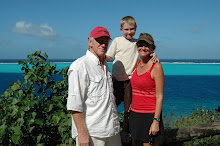The Great Barrier Reef (GBR, not to be confused with PBR in Wisconsin) runs
along the NE coast of Australia for over 1600 miles. It varies from over 60
miles off shore to only 15 – 20 miles as it nears the northern coast. Most areas
of the reef are hard to reach for private boats since it is well offshore, there
are few islands to break up the force of the winds and seas, and the typical
winds during the cruising season are at least 15 – 20 kts causing 4’ – 6’ seas.
Anchoring or hanging out near the reef for diving must be planned carefully and
coordinated with the occasional weather breaks. Most visitors and divers access
the reef on day trips aboard large high speed commercial catamarans which zoom
out and back in all but the worst weather. Many towns along the coast claim to
be the best access point to the reef but Cairns is one of the best with the reef
only an hour away on the fast boats.
We arrived in Cairns in mid June to spend our last month of our cruising
life exploring and diving the GBR. Cairns is a very active tourist town and has
a great marina to base out of. There is only one island in the region that has
reasonably protected anchorage, so you are pretty much restricted to being ‘in
town’ or out on the reef in settled weather. Unfortunately, since we got to
Cairns, it has blown 25 – 30 kts around the clock for over 3 weeks. The reef and
surrounding area has had large seas and we have been holed up in the marina for
most of the time. Two weeks ago, our friends, the Taylors, came over from NZ for
a family vacation and week of diving and the winds continued to howl. We took a
chance and went out to an island approx 2 hrs away to try to find some shelter.
After a couple nights being rocked around and not being able to get out to the
reef, we gave up and returned to the marina. Taylors ended up taking one of the
commercial boats out for a day of diving and reported that most of the
passengers and some of the crew were sick on the way out.
Our cruising partners Glen and Cindy on “Mystery Ship” caught up to us in
Cairns with the same goal of diving on the GBR. We made a plan to watch the
weather forecast and do whatever it took to get out on the reef. Last weekend we
saw a 3 day break in the 20 – 30 kt winds and headed out 60 miles to the NE to
reach one of the more remote areas of the reef (the Agincourt reefs). We were
lucky that the winds obeyed the forecast and we had 10 – 20 kts and were able to
find reasonable protection from the waves anchored behind the reef. It is a
weird sensation to be anchored with nothing in sight in what seems like the
middle of the ocean. The reef remains completely under water, but still breaks
to force of the seas.
We had two days of 2 –3 dives each and finally got to see what the GBR has
to offer. It is estimated that the reef has lost over 50% of it’s coral since
1960, but we still had good dives and saw beautiful coral and many fish. A
couple of Minke whales visited us in the anchorage and got so close we could
almost touch them. We were carefully monitoring the weather and saw that winds
and seas were expected to rebuild late on Sunday afternoon. We pulled anchor
early that morning and headed back to Cairns. Apparently the wind gods were not
paying attention to the forecast and by mid morning we had steady 25 – 30 kts,
gusting to 35+, right on the nose. It was a 7 hour bash and crash all the way
home with the boat falling off steep sharp waves and shaking us like we have not
experienced in nearly two years. Luckily we knew it was going to be a short trip
and hung on for the ride.
It is time for us to start watching the weather in order to head back
towards Brisbane, where we will ship Oso back to the USA. It is nearly 800 miles
back south – mostly into the winds and waves. We have 4 –5 weeks to travel and
hope to sit out the strongest weather and make tracks when it lets up. Our goal
is to revisit some of our favorite places on the Australian coast and minimize
the bashing and crashing in our ‘final voyage’.

